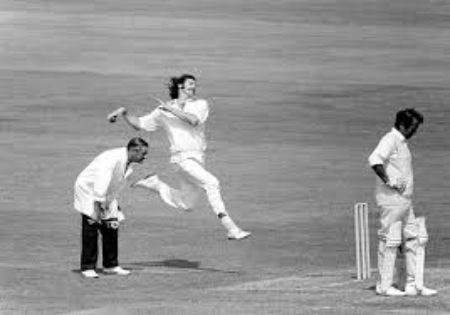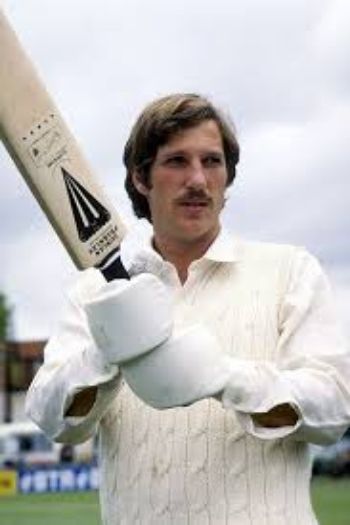England's No.6: Ian Botham
At Headingly in 1981 Ian Botham played his greatest ever innings. Coming in at 5 down for 107 he turned the Test match up-side-down by scoring 149 off only 148 balls. However, during Botham’s iconic innings the Australian captain Kim Hughes committed an obvious tactical blunder that effectively handed Botham his innings. Here are bowling figures for England’s second innings;
Dennis Lillee: 25 Overs – 6 Maidens – 94 Runs – 3 Wickets
Terry Alderman: 35.3 Overs – 6 Maidens – 135 Runs – 6 Wickets
Geoff Lawson: 23 Overs – 4 Maidens – 96 Runs – 1 Wicket
Ray Bright: 4 Overs – 0 Maidens – 15 Runs – 0 Wickets
The amazing fact easily spotted from those figures is that the left-arm spinner Ray Bright bowled only 4 overs during the entire innings despite Botham’s onslaught against the fast bowlers. Bright was no Derek Underwood but he was accurate enough, and more than capable of finding a good line and length. That is, he bowled the type of deliveries necessary for a batsman to ‘hang himself’ when attacking on an unpredictable Headingly pitch. So rather than attempt to get Botham caught at mid-wicket as he slogged across the spin of Bright’s orthodox left-armers, Kim Hughes preferred to watch Botham use the pace of the ball from Lillee and Lawson to thrash it to all points of the outfield. Thus cricket has one of its greatest innings of all time because of the precarious context of the Test match, the series, and Botham’s career which was on the line due to poor form in several previous Tests.
However, it is a truism that great players ‘create their own luck’ and know how to capitalise on an opponents mistake, and Botham was clearly a great player.
Botham scored 3 more centuries during his 59 innings against Australia;
119* MCG 1980 (Lillee, Pascoe, Dymock, Mallett)
118 Old Trafford 1981 (Lillee, Alderman, Whitney, Bright)
138 Brisbane 1986 (Hughes, Reid, C.Matthews, G.Matthews, S. Waugh)
This means that Botham scored a century (about) every 15 innings. This does not appear overly frequent at first glance, but in trying to decide whether a specialist batsman, or another allrounder should occupy England’s No.6 position it is worthwhile making a proper comparison;
ALLROUNDERS
Ian Botham:
Average = 29.35
4 centuries in 59 innings. Ratio = 1 in 15
Frank Woolley:
Average = 33.28
2 centuries in 51 innings. Ratio = 1 in 26
Andrew Flintoff:
Average = 33.56
1 century in 29 innings. Ratio = 1 in 29
Tony Grieg:
Average = 36.19
1 century in 37 innings. Ratio = 1 in 37
SPECIALIST BATSMAN
Maurice Leyland:
Average = 56.83
7 centuries in 34 innings. Ratio = 1 in 5
Walter Hammond:
Average = 51.85
9 centuries in 58 innings. Ratio = 1 in 6
Ken Barrington:
Average = 63.97
5 centuries in 39 innings. Ratio = 1 in 8
David Gower:
Average = 44.78
9 centuries in 77 innings. Ratio = 1 in 9
Kevin Pietersen:
Average = 49.05
4 centuries in 40 innings. Ratio = 1 in 10
Graham Thorpe:
Average = 45.74
3 centuries in 31 innings. Ratio = 1 in 10
Dennis Compton:
Average = 42.84
5 centuries in 51 innings. Ratio = 1 in 10
Peter May:
Average = 46.06
3 centuries in 36 innings. Ratio = 1 in 12
Colin Cowdrey:
Average = 34.27
5 centuries in 75 innings. Ration = 1 in 15
Ted Dexter:
Average = 38.80
2 centuries in 35 innings. Ratio = 1 in 18
Alan Knott:
Average = 32.98
2 centuries = 57 innings. Ratio = 1 in 29
Even though Botham averaged less than the other allrounders, he was more likely to score a century. This makes him at least as equally attractive, if not more so - especially as 3 of his centuries were major factors in England defeating Australia and winning the series.
However, compared to most specialist batsman Botham averaged significantly less. Indeed, he pales in comparison to Maurice Leyland (the surprise package) or Kevin Pietersen. However, in terms of centuries to innings ratio he is better than Dexter, the same as Cowdrey, and not that far off Peter May !
But before we write off Botham and select a specialist batsman we should look at how the respective batting orders compare;
ENGLAND: Batting Averages V AUS
01. Jack Hobbs = 54. 27
02. Len Hutton = 56.47
03. Ted Dexter = 38.80
04. Ken Barrington = 63.97
05. Walter Hammond = 51.85
06. Not yet selected
07. Alan Knott = 32.98
08. Hedley Verity = 18.11
09. John Snow = 15.08
10. Alec Bedser = 14.35
11. Fred Trueman = 12.07
TOTAL RUNS (according to Averages) =
358
AUSTRALIA: Batting Averages V ENG
01. Bob Simpson = 50.18
02. Not yet selected
03. Don Bradman = 89.79
04. Greg Chappell = 45.95
05. Allan Border = 56.32
06. Keith Miller = 33.58
07. Adam Gilchrist = 45.13
08. Richie Benaud = 19.87
09. Ray Lindwall = 22.08
10. Dennis Lillee = 18.04
11. Bill O’Reilly = 10.65
TOTAL RUNS (according to Averages) =
392
The difference between the 2 batting line-ups currently stands at 34 runs per innings. Thus England’s No.6 batsman effectively has to make up the deficit by averaging 34 more runs than the Australian opener soon to be selected. Therefore, the England team are at a disadvantage in batting no matter whether Botham or a specialist batsman is selected.
The same disadvantage applies to England with respect to bowling. If we look at the 4 frontline bowlers then England concedes 3-4 runs per wicket to Australia;
ENGLAND: Bowling Averages V AUS
08. Hedley Verity = 28.97
09. John Snow = 25.61
10. Alec Bedser = 27.49
11. Fred Trueman = 25.30
AVERAGE =
26.61
AUSTRALIA: Bowling Averages V ENG
06. Keith Miller = 22.40
09. Ray Lindwall = 22.45
10. Dennis Lillee = 21.00
11. Bill O’Reilly = 25.36
AVERAGE =
22.80
I should shout out loud that these averages don’t mean too much in the heat of battle, and probably are very different to each players ‘Peak Average’. However, they do serve as a reminder that it is very likely that Australia has an ‘edge’ in both batting and bowling, and that this would probably translate into a series victory.
Therefore, on that basis I see little point in being conservative and selecting a specialist batsman to merely ‘hold the line’. In order to win this hypothetical 10 Test match Ashes series England would have to be aggressive and take a risk with Ian Botham at No.6 in the batting order. Botham would not be as consistent as a specialist batsman but his record suggests that even if scores 1 century then it will probably be at a critical time when his team really needs it.
Also, it is debatable whether 4 frontline bowlers would be good enough to consistently bowl out such a powerful Australian batting line-up. But with Botham’s known strike-power as a medium-fast swing bowler there is more than a reasonable chance. With Bedser and Verity tying down one end, the addition of Botham into the attack at the other end will allow Snow and Trueman the breathing space to operate at full-tilt for longer periods during the innings without compromising the quality of the attack too much. Here are his excellent bowling stat’s against Australia;
Tests = 36
Wickets = 148
Average = 27.66
SR = 57.29
ER = 2.90
5w = 9
10w = 2
In short, England needs the ‘X-Factor’ skills of Botham to have a good shot at defeating Australia. Admittedly, the batting line-up would not be as solid without a specialist batsman at No.6, but this is more than compensated by Botham’s ability to play 'timely' aggressive innings, make key break-throughs when bowling, and take a brilliant catches in the slips.



